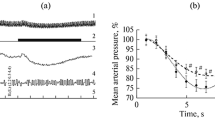Abstract
Dynamic studies were performed in conditions of hypoxia on the effects of stimulation of the ventral, lateral, and medial nuclei of the septum on the spike activity of bulbar respiratory neurons and respiration. The various phases of hypoxia provided a model experiment over which the overall effects of the septal neurons were summed. Electrical stimulation of these septal nuclei in conditions of normal atmospheric pressure had both facilitatory and inhibitory effects on the spike activity of respiratory neurons in the respiratory center of the medulla oblongata, inhibitory effects being predominant. The ventral nucleus had the most effective inhibitory effect on the activity of respiratory neurons. Electrical stimulation of the septal nuclei in the initial phase (4000–5000 m) of hypoxia, on the background of activation, had a predominantly inhibitory influence on the activity of respiratory neurons. During the phase of severe hypoxia (7500–8000 m), on the background of marked hypoxic suppression of respiratory neuron activity, stimulation of the septal nuclei produced no characteristic changes in the activity of these neurons.
Similar content being viewed by others
REFERENCES
N. S. Akopyan, O. G. Baklavadzhyan, and N. V. Sarkisyan, “Responses of medulla oblongata respiratory neurons to stimulation of the nuclei of the amygdaloid complex in hypoxia,” Fiziol. Zh. SSSR, 77,No. 12, 41–49 (1991).
O. G. Baklavadzhyan, Neuronal Organization of the Amygdalo-Visceral Reflex Arc [in Russian], Donetsk (1996).
Ya. Buresh, M. Petran, and I. Zakhar, Electrophysiological Study Methods [in Russian], Moscow (1962).
A. V. Val'dman, Neuropharmacology of Central Regulatory Processes [in Russian], Leningrad (1969).
I. G. Vlasova, “The nerve cell and hypoxia,” in: Proceedings of the VII International Symposium “Ecological-Physiological Problems of Adaptation [in Russian], MV (1994).
M. A. Karapetyan, N. S. Akopyan, and O. G. Baklavadzhyan, “Studies of the hypothalamic mechanisms of regulation of respiratory neuron activity in the medulla oblongata in conditions of hypoxia,” Fiziol. Zh. SSSR, 13,No. 7, 926 (1987).
I. N. Koval', G. T. Sarkisov, and L. S. Gambaryan, The Septohippocampal System and the Organization of Behavior [in Russian], Erevan (1986).
L. B. Nersesyan, O. G. Baklavadzhyan, V. S. Eganova, A. V. Armakyan, N. L. Pogosyan, and R. V. Sarukhanyan, “The role of septal structures in controlling the activity of bulbar respiratory neurons and sympathetic nerves,” Arkh. Klin. Éksper. Med., 9,No. 1, (2000).
I. A. Oivin, “Statistical analysis of experimental data,” Patol. Fiziol. Éksper. Ter., 4,No. 4, 76–85 (1959).
M. O. Samoilov, The Responses of Brain Neurons to Hypoxia [in Russian], Nauka, Leningrad (1985).
E. N. Sokolov and R. P. Steklova, “Activity of rabbit brain neurons during ‘elevation’ and ‘descent’ in a barometric chamber,” Zh. Vyssh. Nerv. Deyat., 24,No. 3, 606–616 (1974).
S. B. Giankola, S. Rodes, and L. Ciriello, “Contribution of caudal ventrolateral medulla to the cardiovascular responses elicited by activation of bed nucleus of the stria terminalis,” Brain Res., 606,No. 1, 162–166 (1993).
T. L. Holstock, “Effect of septal stimulation in rats on heart rate and galvanic skin responses,” Psychonomic Sci., 9, 37–38 (1967).
S. A. Jansen and G. Ciriello, “Projections from the cardiovascular responsive region of bed nucleus of the stria terminalis to medullary catecholaminergic cell groups,” J. Neurosci. Abstr., 17, 706 (1991).
A. D. Loewy, “Forebrain nuclei involved in autonomic control,” Progr. Brain Res., 87, 253–268 (1991).
L. J. Martin, R. E. Powers, T. L. Dellovade, and D. L. Price, “The bed nucleus-amygdala continuum in human and monkeys,” J. Comp. Neurol., 309,No. 4, 445–485 (1991).
A. Pisani, R. Calabresi, and G. Bernardi, “Hypoxia in strial and cortical neurons: membrane potential and Ca2+ measurements,” Neuroreport, 8,No. 5, 1143–1147 (1997).
P. E. Sawchenko and L. W. Swanson, “The organization of the brain afferents to the paraventricular and supraoptic nuclei in the rat,” J. Comp. Neurol., 218, 121–144 (1983).
B. K. Siesjo, “Lactic acidosis in the brain: occurrence, triggering mechanisms and pathophysiological importance,” in: Metabolic Acidosis, London (1982).
Author information
Authors and Affiliations
Rights and permissions
About this article
Cite this article
Akopyan, N.S., Adamyan, N.Y., Sarkisyan, N.V. et al. Responses of Respiratory Neurons in the Medulla Oblongata to Stimulation of the Septal Nuclei during Hypoxia. Neurosci Behav Physiol 34, 105–108 (2004). https://doi.org/10.1023/B:NEAB.0000003254.69342.6e
Issue Date:
DOI: https://doi.org/10.1023/B:NEAB.0000003254.69342.6e



